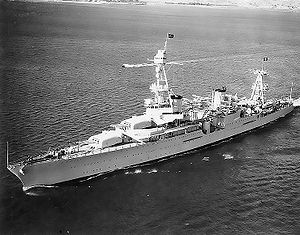 USS Houston off San Diego, California, in October 1935, with President Franklin D. Roosevelt on board. |
|
| Career | |
|---|---|
| Laid down: | 1 May 1928 |
| Launched: | 7 September 1929 |
| Commissioned: | 17 June 1930 |
| Nickname: | "Galloping Ghost of the Java Coast" |
| Honors and awards: |
2 × battle stars, 1 × Presidential Unit Citation |
| Fate: | Sunk in the Battle of Sunda Strait, 1 March 1942 |
| General characteristics | |
| Type: | Northampton-class heavy cruiser |
| Displacement: | 9,050 long tons (9,200 t) |
| Length: | 569 ft (173 m) (w/l); 600 ft 3 in (182.96 m) o/a |
| Beam: | 66 ft 1 in (20.14 m) |
| Draft: | 16 ft 4 in (4.98 m) (mean); 23 ft (7.0 m) (maximum) |
| Installed power: | 107,000 shp (80,000 kW) |
| Propulsion: | 4 × Parsons turbines 8 × White-Forster boilers 4 × shafts |
| Speed: | 33 kn (38 mph; 61 km/h) |
| Range: | 13,000 nmi (15,000 mi; 24,000 km) at 15 kn (17 mph; 28 km/h) |
| Capacity: | 1,500 tons of fuel oil |
| Complement: | 1,020–1,155 officers and enlisted |
| Armament: | 9 × 8 in (203mm) guns (3x3) 4 × 5 in (127 mm) AA guns[1] (4x1) 8 × .50 in (12.7 mm) machine guns 6 × 21 in (530 mm) torpedo tubes |
| Armor: | |
| Aircraft carried: | 4 × floatplanes |
| Aviation facilities: | 2 × catapults |
USS Houston (CA-30) (originally designated CL-30), nicknamed the "Galloping Ghost of the Java Coast", was a Northampton-class heavy cruiser of the United States Navy. She was the second Navy ship to bear the name "Houston".
She was launched by Newport News Shipbuilding & Dry Dock Company, Newport News, Virginia on 7 September 1929, sponsored by Elizabeth Holcombe (daughter of Oscar Holcombe, then-mayor of Houston, Texas), and commissioned as CL-30 on 17 June 1930, Captain Jesse Bishop Gay commanding. Her designation was changed to CA-30 on 1 July 1931.
|
Contents
|
Inter-war period
After conducting a shakedown cruise in the Atlantic, Houston returned to the United States in October 1930. She then visited her namesake city Houston, Texas, and joined the fleet at Hampton Roads. Steaming to New York, the cruiser departed on 10 January 1931 for the Pacific, and after stopping at the Panama Canal and the Hawaiian Islands arrived Manila on 22 February. Houston became flagship of the Asiatic Fleet upon arrival, and for the next year participated in training operations in the troubled Far East.
With the outbreak of war between China and Japan in 1931, Houston got underway on 31 January for Shanghai to protect American lives and property. She landed Marine and Navy gun platoons to help stabilize the situation and remained in the area, with the exception of a good will cruise to the Philippines in March and one to Japan in May 1933, until being relieved by Augusta on 17 November 1933. The cruiser sailed to San Francisco to join the Scouting Force, and for the years preceding World War II participated in Fleet Problems and maneuvers in the Pacific.
During this period, Houston made several special cruises. President Franklin Roosevelt came onboard on 1 July 1934 at Annapolis, Maryland, for a cruise of almost 12,000 nmi (14,000 mi; 22,000 km) through the Caribbean and to Portland, Oregon, by way of Hawaii. Houston also carried Assistant Secretary of the Navy Henry L. Roosevelt on a tour of the Hawaiian Islands, returning to San Diego on 15 May 1935.
After a short cruise in Alaskan waters, the cruiser returned to Seattle and embarked the President again on 3 October for a vacation cruise to the Cerros Islands, Magdalena Bay, Cocos Islands, and Charleston, South Carolina. Houston also celebrated the opening of the Golden Gate Bridge at San Francisco on 28 May 1937, and carried President Roosevelt for a Fleet Review at the same city on 14 July 1938.
Houston became flagship of the U.S. Fleet on 19 September, when Rear Admiral Claude C. Bloch brought his flag aboard, and maintained that status until 28 December, when she returned to the Scouting Force. Continuing the now-familiar routine of training exercises, she got underway for Fleet Problem XX, on 4 January 1939 from San Francisco, sailed to Norfolk and Key West, and there embarked the President and the Chief of Naval Operations, Admiral William D. L